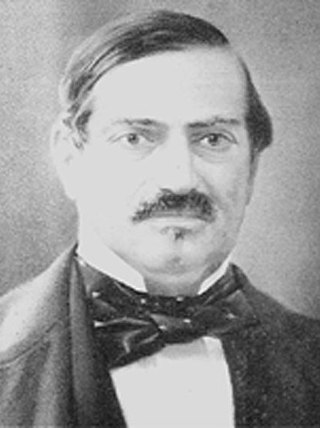
Urbano Pio Francesco Rattazzi was an Italian politician and statesman.

Luigi Federico Menabrea, later made 1st Count Menabrea and 1st Marquess of Valdora, was an Italian statesman, general, diplomat, and mathematician who served as the seventh prime minister of Italy from 1867 to 1869.

Agostino Depretis was an Italian statesman and politician. He served as Prime Minister of Italy for several stretches between 1876 and 1887, and was leader of the Historical Left parliamentary group for more than a decade. He is the fourth-longest serving Prime Minister in Italian history, after Benito Mussolini, Giovanni Giolitti and Silvio Berlusconi, and at the time of his death he was the longest-served. Depretis is widely considered one of the most powerful and important politicians in Italian history.

Cartosat-1 is a stereoscopic Earth observation satellite in a Sun-synchronous orbit, and the first one of the Cartosat series of satellites. The eleventh satellite of ISRO in Indian Remote Sensing Satellite (IRS) series. The satellite was launched by Indian Space Research Organisation and is operated by NTRO. Weighing around 1560 kg at launch, its applications will mainly be towards cartography in India.

The Battle of Aspromonte, also known as the Day of Aspromonte, was a minor engagement that took place on 29 August 1862, and was an inconclusive episode of the Italian unification process. It is named after the nearby mountain of Aspromonte in southern Italy. Giuseppe Garibaldi's army of volunteers was attacked by the Royal Italian Army while marching from Sicily towards Rome, capital of the Papal States, which it intended to annex into the newly created Kingdom of Italy. In the fighting, which took place a few kilometers from Gambarie, Garibaldi was wounded and taken prisoner.

The Minister of Foreign Affairs is the head of the Ministry of Foreign Affairs in Italy. The office was one of the positions which Italy inherited from the Kingdom of Sardinia where it was the most ancient ministry of the government: this origin gives to the office a ceremonial primacy in the Italian cabinet.

Susanna Agnelli, Contessa Rattazzi,, was an Italian politician, businesswoman, and writer. Involved in Italian politics for over twenty years, she was the first woman to be appointed Italian Minister of Foreign Affairs. She was also the first Italian minister to be Minister of Foreign Affairs and undersecretary of the same ministry.

Marie-Lætitia de Solms née Bonaparte-Wyse, was a French author and literary hostess.
General elections were held in Italy on 27 January 1861, with a second round on 3 February. The newly elected Parliament first convened in Turin on 4 March 1861, where, thirteen days later, it declared the unification of the country as the Kingdom of Italy.
General elections were held in Italy on 22 October 1865, with a second round of voting on 29 October. It was the second one in the history of Italy.
General elections were held in Italy on 10 March 1867, with a second round on 17 March. Before the elections, Bettino Ricasoli resigned as Prime Minister due to a disagreement with the Chamber; the Chamber disapproved of his agreements with the Vatican regarding the repatriation of certain religious properties. These snap elections resulted in Urbano Rattazzi being elected once again to office.
General elections were held in Italy on 20 November 1870, with a second round of voting on 27 November. They were a snap election, called by Prime Minister Giovanni Lanza to take advantage by the Capture of Rome and to give parliamentary representation to the future capital of Italy.
The Right group, later called Historical Right by historians to distinguish it from the right-wing groups of the 20th century, was an Italian conservative parliamentary group during the second half of the 19th century. After 1876, the Historical Right constituted the Constitutional opposition toward the left governments. It originated in the convergence of the most liberal faction of the moderate right and the moderate wing of the democratic left. The party included men from heterogeneous cultural, class, and ideological backgrounds, ranging from Anglo-Saxon individualist liberalism to Neo-Hegelian liberalism as well as liberal-conservatives, from strict secularists to more religiously-oriented reformists. Few prime ministers after 1852 were party men; instead they accepted support where they could find it, and even the governments of the Historical Right during the 1860s included leftists in some capacity.
The Left group, later called Historical Left by historians to distinguish it from the left-wing groups of the 20th century, was a liberal and reformist parliamentary group in Italy during the second half of the 19th century. The members of the Left were also known as Democrats or Ministerials. The Left was the dominant political group in the Kingdom of Italy from the 1870s until its dissolution in the early 1910s.

The Rattazzi I government of Italy held office from 3 March 1862 until 8 December 1862, a total of 280 days, or 9 months and 5 days.

The La Marmora II government of Italy held office from 28 September 1864 until 31 December 1865, a total of 459 days, or 1 year, 3 months and 3 days.

The Ricasoli II government of Italy held office from 20 June 1866 until 10 April 1867, a total of 294 days, or 9 months and 21 days. It was also known as the Government of National Reconciliation, because it led Italy during the Third War of Independence.

The Minister of War of Italy, was the minister responsible for the Ministry of War and the Royal Italian Army. The position was abolished with the creation of the position for Minister of Defence.

Raffaele Conforti was an Italian politician and senator of the Kingdom of Italy. He was a leading figure of the Risorgimento and the unification of Italy.













